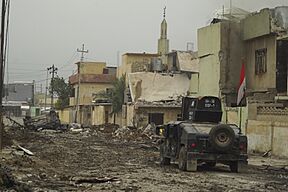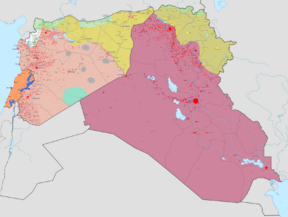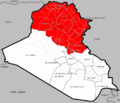War against the Islamic State facts for kids
Quick facts for kids War against the Islamic State |
|||||||
|---|---|---|---|---|---|---|---|
| Part of the war on terror, Second Libyan Civil War, War in Iraq (2013–2017), Syrian civil war and spillover of the Syrian civil war, Sinai insurgency, Boko Haram insurgency, insurgency in the North Caucasus, Moro conflict, Insurgency in Cabo Delgado, Qandala campaign and the Sahel War | |||||||
Map of the current military situation in Iraq, Syria, and Lebanon Map of the current military situation in Libya Map of the current military situation in Nigeria Map of the current military situation in Sinai Map of the current military situation in Yemen |
|||||||
|
|||||||
| Belligerents | |||||||
In multiple regions:
In Iraq: In Syria:
In Gaza: In Libya:
In Afghanistan: In West Africa:
|
|
||||||
| Commanders and leaders | |||||||
|
|
|
||||||
| Strength | |||||||
|
United States:
4,100 troops (in Iraq)
2,500 troops (in Kuwait) 7,000 contractors 500 soldiers to retrain the Iraqi army Australia:
400 RAAF personnel
200 special forces troops 300+ regular soldiers (combined with 100+ New Zealand soldiers) Canada:
Up to 200 special forces advisers
830 Canadian Armed Forces personnel Germany:
1200 troops
Italy:
130 search and rescue team
1,200 troops Russia:
4,000 personnel
Iran:
500 Quds Force members
1,500 Basijis Nigeria:
Army: 130,000 active frontline troops. 32,000 active reserve troops.
Police Force: 371,000 officers Cameroon:
20,000 soldiers
African Union:
8,700 soldiers
Syrian Salvation Government:
50,000+ soldiers
Islamic Front (2013-2015); 26,000-30,000 soldiers |
ISIL:
200,000 in Iraq and Syria (claim by Iraqi Kurdistan Chief of Staff)
28,600–31,600 in Iraq and Syria (Defense Department estimate) 35,000–100,000 (State Department estimate) 1,500+ in Egypt 6,500–10,000 in Libya 7,000–10,000 in Nigeria 1,000–3,000 in Afghanistan At least 400 in the Philippines and Malaysia Up to 600 tanks |
||||||
| Casualties and losses | |||||||
|
|
80,000+ militants killed overall |
||||||
|
13,568+ Iraqi civilians killed by Islamic State 8,317–13,190 civilians killed by Coalition airstrikes in Iraq and Syria (per Airwars) 4,096–6,085 civilians killed by Russian airstrikes in Syria 3,300,000 Iraqi civilians displaced |
|||||||
Imagine a group called the Islamic State, also known as ISIS. In 2014, this group started taking over a lot of land in Iraq and Syria. They did many terrible things, like hurting people and breaking human rights. Because of this, many countries around the world decided to step in and stop them. This big effort is often called the war against the Islamic State or the war against ISIS.
Over time, these efforts greatly weakened ISIS. By 2019-2020, ISIS was much less powerful. While some fighting still happens in Syria, ISIS is now mostly contained to a very small area.
Contents
What is ISIS?
ISIS stands for the Islamic State of Iraq and Syria. It is a very dangerous group that wants to create its own state using violence. They do not follow the true teachings of Islam. They have caused a lot of suffering and instability in the Middle East.
How the Fight Against ISIS Began
In June 2014, ISIS was growing very fast. They took over many areas in northern Iraq. This made many countries worried about their actions.
- Iran started using drones to watch over Iraq. They also sent soldiers to help fight ISIS.
- The United States sent a small number of troops to Iraq. They also started flying planes over the country.
- In July 2014, Iran sent special fighter jets called Sukhoi Su-25s to Iraq.
- A group called Hezbollah also sent trainers to help local fighters. These local fighters were called Shia militias. They helped watch ISIS's movements.
In August 2014, both the US and Iran started bombing ISIS targets in Iraq. These were separate bombing campaigns at first.
Countries Join the Fight
Soon, many other countries joined the fight against ISIS. A group of fourteen countries, led by the US, began bombing ISIS targets. They attacked ISIS in both Iraq and Syria.
Starting in September 2014, the United States worked closely with Saudi Arabia and Jordan. They planned air attacks together against ISIS across Iraq and Syria.
Russia's Role
In September 2015, Russia also joined the fight in Syria. Russia supported its ally, Bashar al-Assad, who was the leader of Syria. Russia said it was fighting ISIS. However, many of Russia's bombings actually targeted other Syrian rebel groups. These groups were fighting against Assad's government.
The United States and its allies did not support Assad's government. They believed Assad had used chemical weapons and hurt his own people. The US-led group trained and supported other groups. These included the Free Syrian Army and Syrian Democratic Forces. These groups were fighting against both ISIS and Assad's government.
ISIS Loses Ground
After all these air attacks began, ISIS started to lose control of land. They lost areas in both Iraq and Syria. Sadly, many innocent people also died from the airstrikes during 2015 and 2016.
In 2016, the US and Russia planned to work together on airstrikes. But this plan did not happen.
ISIS is Defeated (Mostly)
By December 2017, ISIS had lost almost all its land in Iraq. Iraq officially announced victory against ISIS on December 9, 2017. This meant the war in Iraq was over.
On March 23, 2019, ISIS was also defeated in Syria. They lost their last major battle in a place called Baghuz Fawqani. After this, ISIS could no longer control large areas. They became a smaller group that used surprise attacks.
The leader of ISIS, Abu Bakr al-Baghdadi, died in October 2019. He was killed during a special operation by US forces in northern Syria. A new leader, Abu Ibrahim al-Hashimi al-Qurashi, took his place.
In August 2020, the United Nations estimated that over 10,000 ISIS fighters were still in Syria and Iraq. Most of these were hidden groups, ready to cause trouble.
Images for kids
-
U.S. soldiers from 1st Battalion, 6th Infantry Regiment near an oil facility in eastern Syria, 27 October 2020
-
A U.S. Green Beret demonstrates how to quickly fix a firearm malfunction to Revolutionary Commando Army fighters at al-Tanf garrison, 13 March 2020
-
U.S. Navy launching Tomahawk missiles from the Persian Gulf and the Red Sea against ISIL targets in Syria, 23 September 2014
-
Raqqa suffered extensive damage during the Battle of Raqqa
-
RAF Tornado GR4 over Iraq on an armed reconnaissance mission.
-
ISIL's territory, in grey, at the time of its greatest territorial extent in May 2015
-
Combined Air and Space Operations Center (CAOC) at Al Udeid Air Base, Qatar, provides command and control of air power throughout Iraq and Syria.
-
Combined Joint Task Force – Operation Inherent Resolve (CJTF–OIR) personnel pose for a picture during the Syrian intervention, 15 July 2021
See also
- 2003 invasion of Iraq
- Arab Winter
- Combined Joint Task Force – Operation Inherent Resolve
- Iraq War
- List of wars and battles involving ISIL
- Northern Iraq offensive (June 2014)
- Timeline of the Syrian Civil War (August 2014–present)























